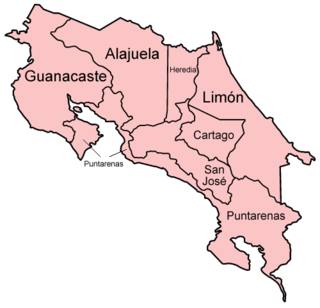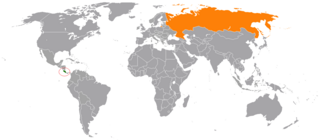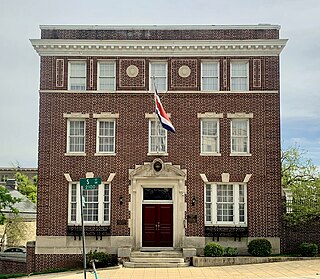| |||||
| Decades: | |||||
|---|---|---|---|---|---|
| See also: | |||||
Events in the year 1960 in Costa Rica .
| |||||
| Decades: | |||||
|---|---|---|---|---|---|
| See also: | |||||
Events in the year 1960 in Costa Rica .

Costa Rica, officially the Republic of Costa Rica, is a country in the Central American region of North America. It borders Nicaragua to the north, the Caribbean Sea to the northeast, Panama to the southeast, and the Pacific Ocean to the southwest, as well as maritime border with Ecuador to the south of Cocos Island. It has a population of around five million in a land area of nearly 51,180 km2 (19,760 sq mi). An estimated 352,381 people live in the capital and largest city, San José, with around two million people in the surrounding metropolitan area.

According to Article 168 of the Constitution of Costa Rica, the political divisions are officially classified into 3 tiers of sub-national entities.

The Costa Rica national football team represents Costa Rica in men's international football. The national team is administered by the Costa Rican Football Federation (FEDEFUTBOL), the governing body for football in Costa Rica. It has been a member of the Fédération Internationale de Football Association (FIFA) since 1927, the Confederation of North, Central American and Caribbean Association Football (CONCACAF) since 1961, and a member of the Central American Football Union (UNCAF) since 1990.

Costa Rica competed at the 1980 Summer Olympics in Moscow, USSR. The Costa Rican contingent comprised 29 competitors in five sports. Maria del Milagro Paris, a swimmer, was the only woman among Costa Rican competitors.

Costa Rica competed at the 1992 Summer Olympics in Barcelona, Spain. 16 competitors, 11 men and 5 women, took part in 18 events in 6 sports. They did not win any medals.
The Caribbean Lowlands are region of plains along the eastern coast of several Central American nations along the Caribbean Sea, including Belize, Honduras, Nicaragua, Costa Rica, and Panama.

The Costa Rican Football Federation, also known as FEDEFUTBOL or FEDEFUT, is the official association football governing body in Costa Rica and is in charge of the Costa Rica national football team and the Costa Rica women's national football team.

Costa Rica competed at the 1984 Summer Olympics in Los Angeles, United States. The Costa Rican contingent comprised 30 competitors in 5 sports. They did not win any medals.

Calyptrogyne is a genus in the palm family (Arecaceae). It is distributed across Central America, Colombia, and southern Mexico, with 11 of the 17 known species endemic to Panama. Calyptrogyne ghiesbreghtiana is the most widespread and best studied species in this genus.

Costa Rica competed at the 1964 Summer Olympics in Tokyo, Japan. Orlando Madrigal, a judoka, was the flag bearer for Costa Rica at the 1964 Games.

Costa Rica competed at the 1972 Summer Olympics in Munich, West Germany. Three competitors, all men, took part in four events in three sports. The Costa Rican contingent did not win any medals.
The Costa Rica men's national tennis team represents Costa Rica in Davis Cup tennis competition and are governed by the Federación Costarricense de Tenis.

Costa Rica Cricket Federation is the official governing body of the sport of cricket in Costa Rica and is in charge of the Costa Rica national cricket team.

Football is the most popular sport in Costa Rica. Costa Rica has long been considered an exporter of footballers within Central America, with 19 players in European professional football leagues during 2006. The newspaper, La Nación, has prepared an annual census of these "Legionnaires" since 1994.

The bilateral relations between Costa Rica and Russia date back to 1872, when Costa Rican president Tomás Guardia and Emperor of Russia Alexander II exchanged correspondence. Relations were not formally established until 1944, at the final stages of World War II, when the Russian Empire was already succeeded by the Soviet Union.
The Guatemala national rugby union team represents Guatemala in rugby union.

The Costa Rica women's national football team represents Costa Rica in women's international football. The national team is controlled by the governing body Costa Rican Football Federation. They are one of the top women's national football teams in the Central American region along with Guatemala and Panama.

The Embassy of Costa Rica in Washington, D.C. is the diplomatic mission of Costa Rica to the United States. It is located at 2114 S Street Northwest, Washington, D.C. in the Kalorama neighborhood.
Capital punishment in Costa Rica was abolished in 1877. Costa Rica was one of five countries to abolish the death penalty for all crimes prior to the beginning of the 20th century.
Costa Rica women's national under-20 football team represents Costa Rica in international youth football competitions.